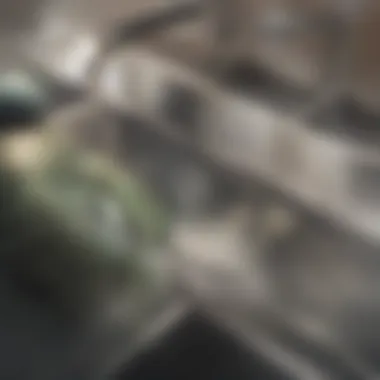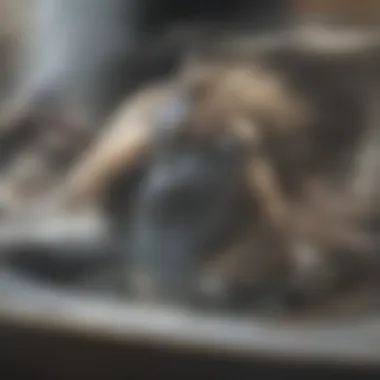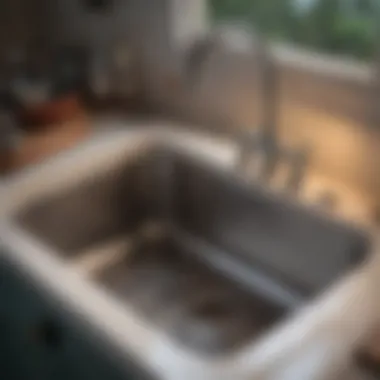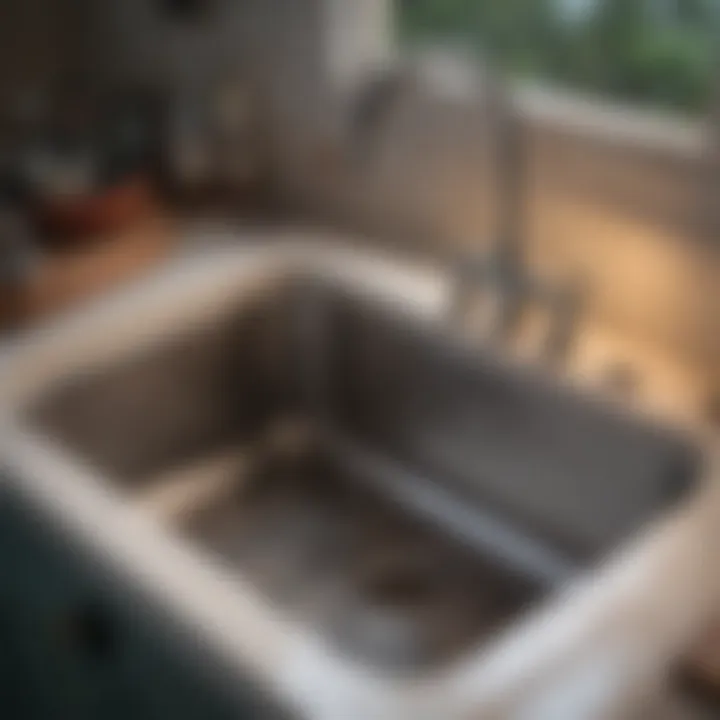Natural Solutions for Kitchen Sink Clogs


Intro
Kitchen sink clogs pose a frequent inconvenience in households. Often, they arise from accumulated grease, food particles, or hair, leading to frustrating moments when one realizes the sink is not draining. It is important to address this issue promptly, not only to restore functionality but also to prevent further plumbing complications.
Fortunately, several home remedies can effectively tackle this problem without resorting to chemical cleaners, which can harm the environment and plumbing system. This article will delve into these natural methods, offering insights into their ingredient compositions, procedural steps, and potential limitations.
Using these remedies not only addresses existing clogs but also educates readers on preventive measures that can be taken to maintain kitchen sink efficiency. Each method presented here is designed to be accessible and user-friendly, ensuring that you can approach the challenge of kitchen sink clogs with confidence.
Let’s explore these methods in detail.
Understanding Kitchen Sink Clogs
Understanding kitchen sink clogs is crucial for maintaining a functional and hygienic kitchen environment. These blockages not only disrupt daily cooking and cleaning activities but can also lead to more significant plumbing issues if not addressed in timely manner. Knowing the factors that contribute to clogs can empower homeowners to take effective preventive measures, saving both time and money on expensive repairs.
Common Causes of Clogs
Kitchen sink clogs typically stem from various sources. Some of the most common causes include:
- Food Waste: Leftover food particles often accumulate in the drain. This can happen due to inadequate disposal methods or overloading the garbage disposal system.
- Grease Build-Up: Fatty substances, when washed down the sink, harden as they cool, creating a solid mass that traps other debris.
- Soap Residue: Certain soaps form residues that can combine with grease and food particles, leading to clogs.
- Foreign Objects: Utensils or other items mistakenly dropped can obstruct the drain flow.
Each of these elements plays a significant role in causing a clog. Understanding these causes helps in adopting better practices for waste disposal and overall maintenance in the kitchen.
Impacts of Clogs on Kitchen Functionality
The impacts of clogs extend beyond mere inconvenience. When a kitchen sink drains poorly, it affects:
- Hygiene: Standing water can foster bacterial growth, causing unpleasant odors and potential health risks.
- Workflow: Cooking and clean-up processes become cumbersome, leading to inefficiencies in meal preparation.
- Plumbing Issues: Over time, persistent clogs can lead to serious plumbing problems, which may require professional intervention or system replacements.
Addressing these clogs promptly can mitigate their effects, ensuring a smoother and safer kitchen experience. The more you know about the origins and implications of these clogs, the better prepared you will be to prevent and handle them.
"Preventing kitchen sink clogs begins with understanding their causes and impacts on overall kitchen functionality."
By remaining informed about kitchen sink clogs, homeowners can develop sustainable practices that enhance their kitchen efficiency and maintain the integrity of their plumbing system.
Precautionary Measures
Understanding and implementing precautionary measures is crucial for maintaining the efficiency of your kitchen sink and preventing clogs. The strategies discussed here serve as the first line of defense. They not only aid in keeping your sink clear but also extend the lifespan of your plumbing. By adopting careful practices, you can mitigate future disruptions in your kitchen activities.
Regular Maintenance Practices
Regular maintenance of your sink can make a significant difference in preventing clogs. A proactive approach helps identify minor issues before they escalate. Here are some effective practices:
- Clean Sink Drains: Regularly inspect and clean the sink drain area. Remove food particles and debris that may accumulate. A simple routine of wiping down can prevent buildup.
- Use Drain Screens: Install drain screens or stoppers. These devices catch food debris, preventing it from going down the drain and causing blockages.
- Flush Hot Water: Pouring hot water down the drain once a week can help dislodge any grease or buildup. It serves as an effective preventive measure, especially after cooking.
These practices do not require much time yet yield significant benefits in maintaining a clog-free kitchen.
Best Practices for Kitchen Disposal
Proper disposal of kitchen waste plays a vital role in keeping the sink functional. Following certain best practices ensures that you dispose of food items in a way that reduces the risk of clogs:
- Avoid Hard-to-Dispose Items: Foods like grease, coffee grounds, and fibrous vegetables should never be poured down the sink. Instead, dispose of them in your compost or trash bin.
- Dispose of Food Waste in Small Quantities: When using a garbage disposal unit, feed it small amounts of food waste at a time. This approach helps to prevent overwhelming the system and allows for proper grinding.
- Emphasize Recycling: Scraps such as egg shells and fruit peels should be recycled or composted. This not only reduces clog risk but also contributes to environmental sustainability.
Maintaining good disposal habits is essential. By ensuring that only appropriate materials go down the drain, you can significantly lower the risk of clogs.
Vinegar and Baking Soda Solution
The vinegar and baking soda solution stands out as a popular and efficient remedy for kitchen sink clogs. This combination is notable for being cost-effective and environmentally friendly. Many households have vinegar and baking soda readily available, making it an accessible option for addressing clogs. Utilizing this solution not only helps to maintain a clean sink but also contributes to the overall longevity of plumbing systems.


Composition and Benefits
The active components in the vinegar and baking soda solution are acetic acid and sodium bicarbonate. When these two ingredients are mixed, they undergo a chemical reaction that produces carbon dioxide gas, resulting in fizzing and bubbling. This effervescent action plays a vital role in dislodging debris that may be stuck in the pipes.
There are several key benefits to employing this method:
- Non-toxic: This solution does not release harmful chemicals into the environment, making it a safe choice for households with children and pets.
- Cost-effective: Both vinegar and baking soda are inexpensive and widely available at grocery stores.
- Minimal equipment required: No specialized tools or equipment are necessary; just standard kitchen items suffice.
- Preventative measure: Regular use can help to prevent future clogs by keeping pipes clear of buildup.
Application Process
To apply the vinegar and baking soda solution effectively, follow these steps:
- Clear the sink: Remove any standing water, food particles, or debris from the sink to ensure proper drainage.
- Add baking soda: Pour about half a cup of baking soda directly down the drain.
- Add vinegar: Follow the baking soda with half a cup of vinegar. Expect fizzing, which indicates the reaction is taking place.
- Let it sit: Allow the mixture to sit for at least 15 to 30 minutes to maximize effectiveness.
- Flush with hot water: After the waiting period, flush the drain with hot water. Doing so helps to wash away any loosened debris.
This solution, while simple, can delegate a powerful impact on maintaining clear kitchen drains.
Consistency is key. For ongoing maintenance, consider using this remedy once a month, particularly in kitchens that use a garbage disposal or where food waste regularly enters the drain. With such a simple and effective method at hand, addressing kitchen sink clogs becomes much less of an ordeal.
Hot Water Treatment
Hot water treatment is a simple yet often overlooked home remedy for kitchen sink clogs. The role of hot water in unclogging drains is multifaceted. It acts effectively to dissolve grease and food particles that typically contribute to blockages. When combined with other remedies, hot water can enhance overall effectiveness, making it a key player in maintaining a clear drain.
Effectiveness of Hot Water
The effectiveness of hot water in unclogging kitchen sinks lies in its thermal capacity. Heat can break down stubborn grease more easily than cold water. Grease tends to solidify at lower temperatures, thereby causing clogs. When hot water is poured into the drain, it helps to melt these greasy build-ups, allowing them to flow freely through the pipes.
In addition to grease, hot water assists in loosening food debris that may have stuck to the edges of the pipes. This loosening effect creates a more favorable condition for gravity to do its work, carrying waste down and out of the drain. However, one should consider the type of plumbing present. Older pipes or those made from certain materials can be sensitive to extreme temperatures. Therefore, it is wise to opt for moderately hot water instead of boiling water, to prevent any potential damage.
Best Methods for Implementation
Implementing hot water treatment for kitchen sink clogs requires a few steps. Here are some best practices:
- Boil Water: Start by simmering water in a pot or kettle.
- Pour Slowly: Once the water reaches a hot but not boiling point, carefully pour it directly into the drain. This helps limit any sudden temperature changes that could harm older plumbing.
- Repeat as Necessary: For stubborn clogs, repeated applications may be necessary. Allow it to sit for a few minutes before pouring in another batch of hot water.
- Combine with Other Remedies: For enhanced results, consider using hot water in conjunction with vinegar or baking soda. After pouring hot water, you can add one of these remedies for a two-pronged approach.
Hot water serves as an effective initial treatment, making it especially useful just after a meal when grease build-ups are fresh.
Overall, hot water treatment serves as a proactive measure to prevent future clogs, not just a fix for existing issues. Regularly flushing your kitchen sink with hot water can significantly increase its longevity and reduce the chances of blockages.
Salt and Baking Soda Mixture
In the realm of home remedies, the combination of salt and baking soda has gained recognition for its ability to address kitchen sink clogs. This mixture represents a suitable alternative to harsh chemical cleaners, providing a natural and non-toxic solution for clogged drains. Understanding its importance is crucial for those seeking effective maintenance methods for their kitchens.
The efficacy of this remedy lies in the natural properties of both salt and baking soda. Salt, a natural abrasive, aids in breaking down buildup within pipes, while baking soda is an agent that reacts with acids to enable a fizzing action. These characteristics combine to create a powerful duo that not only alleviates current clogs but may also prevent future blockages.
How it Works
The mechanism of action for the salt and baking soda mixture involves a simple chemical reaction. When mixed together, the two ingredients create a reaction that produces carbon dioxide gas. This gas produces bubbles, which can help dislodge food particles and grease lining the pipes. Furthermore, as the mixture travels through the plumbing, the abrasive nature of salt aids in scrubbing the inner walls of the pipes. This dual action makes it effective against a range of common clogging agents such as oil residue, hair, and food scraps.
In addition to their physical effects, both baking soda and salt have properties that remove odor and bacteria. This means that using this mixture not only clears clogs but can help maintain a fresher environment in the kitchen.
Step-by-Step Application
To effectively apply the salt and baking soda mixture to unclog your kitchen sink, follow these steps:
- Gather Your Materials: You will need one cup of baking soda, one cup of salt, and boiling water.
- Combine Salt and Baking Soda: In a bowl, mix the salt and baking soda together thoroughly.
- Pour into the Drain: Slowly and evenly, pour the salt and baking soda mixture directly down your clogged kitchen sink drain.
- Allow it to Sit: Let the mixture sit for 15-30 minutes. This waiting period allows the ingredients to react and penetrate the clog effectively.
- Flush with Boiling Water: After letting the mixture work, carefully pour boiling water down the drain. The hot water will help dissolve any remaining residue and carry it away.
- Repeat if Necessary: If the clog persists, you can repeat the process again after a short interval.
By following these straightforward steps, the salt and baking soda mixture can become a reliable method in your toolkit for maintaining a clear kitchen sink.
Dish Soap and Hot Water Method


The Dish Soap and Hot Water method is a straightforward yet effective remedy for addressing kitchen sink clogs. This technique leverages the properties of common household items, making it both economical and accessible. Dish soap serves as a lubricant, while hot water works to dissolve grease and food particles that may contribute to clogs. By understanding how this method operates, individuals can save themselves time and frustration when faced with slow-draining sinks.
Why This Works
The effectiveness of the Dish Soap and Hot Water method lies in the chemical properties of the soap combined with the physical properties of hot water. Dish soap is designed to break down grease and residue. When combined with hot water, it becomes an effective agent that can clear blocked pipes. The heat from the water loosens up dirt and grime, enabling the soap to emulsify these substances, making them easier to wash down the drain. Moreover, the viscosity of the soap ensures that it clings to the sides of the pipes, helping to further dislodge any build-up that may have formed over time.
Procedure for Use
To effectively implement the Dish Soap and Hot Water method, follow these simple steps:
- Gather Your Materials: You will need liquid dish soap and boiling water. Make sure the water is hot enough to help break down the grease but not so hot that it could damage your plumbing.
- Pour the Dish Soap: Start by pouring a generous portion of dish soap directly into the drain. Approximately half a cup should suffice, depending on the severity of the clog.
- Let it Sit: Allow the soap to sit in the drain for about 10 to 15 minutes. This waiting period enables the soap to penetrate through the clog.
- Add Hot Water: After the waiting time is complete, carefully pour the boiling water down the drain. This should be done slowly to ensure that it mixes well with the soap.
- Repeat if Necessary: For stubborn clogs, it may be necessary to repeat the process. If the blockage persists, consider combining this method with other home remedies.
"Using dish soap and hot water is not only effective but also highlights the potential of simple household items in DIY maintenance."
This method is worth trying when experiencing minor clogs as it is non-invasive and cost-effective. By regularly employing this technique, homeowners can help maintain clearer drains and more efficient kitchen sinks.
Wire Hanger Approach
The wire hanger approach to clearing kitchen sink clogs offers a practical and innovative solution using common household items. Utilizing a wire hanger can effectively dislodge clogs and free up any obstructions that standard methods might not reach. This method is particularly valuable as it combines accessibility with efficiency, allowing homeowners to resolve minor blockages without resorting to chemical cleaners or professional help.
Materials Required
To implement the wire hanger approach, one only needs a few simple materials:
- Wire hanger: This should be a standard metal hanger, preferably a sturdy one to withstand bending and manipulation.
- Pliers: Useful for adjusting the shape of the hanger and for any necessary gripping or pulling.
- Gloves: Protects hands from any residual grime or potential hazards present in the sink.
- Flashlight: Helpful for illuminating the drain area, allowing for better visibility.
Implementation Instructions
To effectively use the wire hanger for unclogging a sink, follow these detailed steps:
- Begin by putting on gloves to ensure safety and hygiene.
- Take the wire hanger and straighten it out as much as possible. Leave a small hook at one end, which will aid in grasping the clog.
- If needed, use pliers to bend the hook to create a more effective grabbing tool.
- Insert the hooked end into the sink drain. Be gentle, as pushing too hard might push the clog further down.
- Carefully maneuver the hanger back and forth while pulling upward occasionally. This helps to dislodge the clog, whether it is food particles or other debris.
- Once you feel the obstruction loosen, carefully pull out any debris caught in the hook.
- It may be useful to pour some hot water down the drain afterward to flush away any remaining residues.
This method can save you time and money, allowing you to tackle a common household issue with minimal resources at hand.
Plunger Technique
Using a plunger is fundamental for unclogging kitchen sinks. It is a simple tool that can create enough pressure to dislodge blockages. Knowing how and when to use a plunger can save time and prevent damage to plumbing systems. It is often the first line of defense against stubborn clogs. The effectiveness of this method lies in its mechanical action, as it utilizes pressure and suction to clear obstructions.
When to Use a Plunger
Recognizing the right time to use a plunger is crucial. Typically, it is advisable to use a plunger when:
- Water begins to drain slower than usual.
- The sink fills with water after use, indicating a blockage.
- You notice a foul smell emanating from the sink, which could suggest stagnant water.
Do not wait until water overflows from the sink. Being proactive can prevent further complications. Use the plunger at the first sign of a clog to address the issue before it escalates.
Proper Plunger Usage
Using the plunger correctly is essential for effective unclogging. Here are detailed steps:
- Choose the Right Plunger: Ensure you have a cup plunger, best for flat surfaces like sinks.
- Seal the Overflow Drain: If your sink has an overflow drain, use a wet cloth to block it. This ensures pressure is directed towards the clog.
- Position the Plunger: Place the plunger over the sink drain. Create a tight seal around it.
- Push and Pull: Maintain a firm grip and push down slowly to create a seal. Then pull up quickly, making sure to keep the seal intact. Repeat this motion 15 to 20 times.
- Check the Drainage: After several thrusts, remove the plunger and check the water flow. If it drains, you have likely cleared the clog. If not, repeat the process.
The duration and vigor of your efforts play a significant role in the outcome. Properly implementing this technique can save you the need for more invasive methods or professional services. As with any plumbing issue, if stubborn clogs persist after multiple attempts, it may be time to consider other remedies or professional help.
Professional Intervention: When Necessary
When faced with persistent kitchen sink clogs, knowing when to seek professional help can be crucial. While many home remedies can effectively address minor blockages, some situations may require specialized equipment and expertise to resolve. Recognizing the limits of do-it-yourself methods is key to maintaining a functional kitchen environment.
Recognizing Severe Clogs


Severe clogs often present distinct signs that differ from minor obstructions. If you notice continuous backups, repeated instances of foul odors, or unusual gurgling sounds, these may be indicators of a more serious issue. Other symptoms include water draining very slowly or not at all, and the presence of standing water that refuses to go down.
In such cases, consider the following:
- Multiple Drains Affected: If sinks or other fixtures in your home are also not functioning, this may signal a clog in the main sewer line.
- Unusual Backups: Backups in unexpected places, such as toilets or showers, often indicate systemic issues beyond just kitchen drainage.
- Persistent Odors: Foul smells that persist despite cleaning can signify that waste is trapped somewhere in the pipes.
Ignoring these signals can lead to greater damage and more expensive repairs in the long run. Therefore, it is wise to seek a professional assessment when signs point to a severe clog rather than risking further complications.
Choosing a Professional Service
Selecting the right professional service can make a significant difference in effectively managing sink clogs. Look for plumbing companies with established reputations and transparent pricing. Read reviews and get recommendations to ensure you choose a reliable service.
Abilities of a good plumbing service include:
- Expert Diagnosis: Professionals utilize tools like cameras to visualize the pipe’s interior and accurately identify the obstruction.
- Effective Solutions: Many companies offer a range of solutions from snaking to hydro-jetting, which can clear even the toughest clogs.
- Preventive Advice: A capable plumber can provide valuable insights on maintaining your sink and preventing future clogs, tailored to your specific household needs.
As you consider professional intervention, remember to inquire about warranties or guarantees. This adds a layer of reassurance to the investment you are making in your home’s plumbing integrity.
Environmental Considerations
First, using natural ingredients for unclogging sinks is a sustainable alternative to chemical drain cleaners. Chemical products often contain harsh substances that can harm aquatic life and pollute water sources. In contrast, remedies such as vinegar, baking soda, and hot water pose minimal risk to the environment. By choosing these approaches, individuals contribute to a healthier ecosystem while effectively addressing household issues.
Additionally, home remedies often use ingredients already available in the kitchen. This practice reduces the need for extra purchasing, leading to lower consumption and minimizing waste. For instance, rather than discarding leftover salt or baking soda, one can repurpose these items to clear clogs. This reusability not only promotes sustainability but also encourages mindful consumption.
Finally, considering environmental factors in plumbing maintenance promotes awareness about waste management. Homeowners who actively seek eco-friendly solutions tend to adopt more sustainable practices overall.
"Choosing natural remedies is not just about cleaning; it's about creating a healthier home and community."
Sustainability of Home Remedies
The sustainability of home remedies is rooted in their natural composition and ease of access. Not only do these remedies mitigate immediate issues like clogs, but they also offer a sustainable solution for ongoing maintenance. Utilizing common household items like vinegar and baking soda provides a lower environmental footprint than commercial products.
Moreover, many home remedies are biodegradable, meaning they break down naturally without leaving harmful residues. This contrasts sharply with synthetic chemical cleaners, which may linger in the environment long after their use. Hence, the ecological benefits of employing home remedies extend beyond immediate use.
Regular use of these natural solutions fosters a more environmentally friendly routine. For instance, employing hot water to clear gentle clogs can prevent the buildup of grease and food particles long before a significant blockage occurs. Such proactive measures help maintain a clean and functional kitchen sink without resorting to environmentally damaging methods.
Waste Management Practices
Thoughtful waste management practices are essential when addressing household waste. It's important to recognize that clogged sinks can often be a product of improper disposal methods. Rethinking what goes down the drain is the first step in effective waste management.
For example, avoid pouring grease or food scraps down the kitchen sink. Instead, composting organic waste or disposing of grease in a jar can prevent clogs from forming. Household items should be disposed of in ways that do not compromise plumbing systems.
Additionally, leveraging home remedies supports a more sustainable approach to waste. By employing methods that utilize existing materials, waste is minimized. Recycling items as solutions can drastically decrease one's overall carbon footprint.
Ultimately, effective waste management requires a combination of wise disposal practices and the adoption of environmentally sound remedies. By refraining from using harsh chemicals and instead choosing natural methods, homeowners can participate in an eco-conscious lifestyle while effectively managing their kitchen sinks.
Final Thoughts
Summarizing Key Remedies
In summarizing key remedies, it is crucial to revisit the most effective strategies presented. Various methods such as the vinegar and baking soda solution, hot water treatment, and dish soap techniques are highlighted for their simplicity and effectiveness. Each remedy operates on different principles:
- Vinegar and Baking Soda Solution: Utilizes the chemical reaction between vinegar and baking soda to break down clogging materials.
- Hot Water Treatment: Effective for dissolving grease and debris, making it a simple yet powerful approach.
- Salt and Baking Soda Mixture: This combination works effectively to loosen blockages before flushing them away.
- Dish Soap and Hot Water: A practical method that utilizes the degreasing properties of dish soap combined with hot water to reduce stubborn grease buildup.
These remedies are easy to carry out and do not require specialized equipment. They illustrate that home solutions can offer significant benefits in managing household issues while being environmentally friendly.
Promoting a Clog-Free Environment
Promoting a clog-free environment involves adopting proactive habits in the kitchen. Here are some effective measures:
- Regular Maintenance: Schedule regular checks for potential clogs, such as inspecting the drain for debris and buildup.
- Mindful Disposal: Be cautious about what goes directly into the sink. Avoid placing unsupported materials like greasy foods, hard particles, or large food scraps down the drain.
- Use of Strainers: Implement strainers in sink drains to catch food particles and prevent them from entering the plumbing.
- Educate Household Members: Ensure that everyone in the household understands the importance of proper waste disposal and the impact of their actions on plumbing health.
These practices contribute to a well-maintained kitchen environment.
"Prevention is always better than cure. Regularly following preventive measures can significantly reduce the need for intensive interventions."







